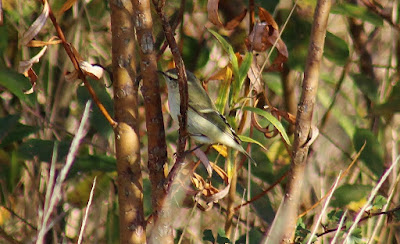Hallowe’en and a day off – but where to go on this spookiest of days? Wicken Fen seemed a suitable choice. Wicken is another name for Rowan, or Mountain Ash, as is Witch Tree, though this is apparently because Rowan is supposed to guard against witchcraft rather than aid it. Well, not a very fenny tree your Rowan, so perhaps in its absence witchcraft abounds on the Fen and, after all, Wicken sounds like Wiccan, so it’s bound to be something to do with witches (actually, according to The University of Nottingham’s ‘Key to English Place-names’ Wicken means ‘At the specialised farms’, but let’s not allow that to spoil things. Probably Toad farms in any case)…
The Fen was approprately fog-shrouded upon my arrival and
would remain so for much of the day. Just about my first sighting was of a Fox,
who sat and watched me from a gateway. More thief than phantom in English
folklore, though there was apparently a belief that witches could turn
themselves into Foxes. A cracking start,
regardless. A couple of hours at the Roger Clarke hide followed. Water Rail and
Jay did their best to offer blood-curdling screams and a lone Magpie flew over,
portending sorrow. It was far too pleasant to worry about that however, with a
steady stream of small birds visiting the feeders, Bullfinches picking through
the last of the Blackberries and a Kingfisher dropping in for an early morning
bathe.
Moving on, the Fen was a study in sepia and grey, with
occasional splashes of colour in the form of vermillion Bramble leaves, scarlet
Guelder Rose berries and shocking-pink Spindle.
Everywhere was still and quiet,
apart from the faint rustle and patter of falling leaves and water droplets.
Birds made sudden appearances from out of the fog and were just as quickly
swallowed back up – Green and Great Spotted Woodpecker, Kestrel, Snipe… Redwing
and Song Thrush skulked within the berry-laden Hawthorns.
What this day needed to get it back on theme was owls, so I
eventually headed down Harrison’s Drove and, failing to find either Little or
Barn at Priory Farm, crossed over onto Burwell Fen. Almost immediately two
Short-Eared Owls appeared and I was to be treated to up to four of these
magnificent birds over the next hour. The sun had even burnt through a little
by this stage, helping to pick up their beautiful markings. Burwell Fen is
awash with Kestrels at the moment, and more than once owl and falcon had a
brief set-to. An owl also decided to harass a Buzzard.
I decided to finish the day over on the boardwalk, hoping
for ghostly Barn Owl or ghosting Hen Harrier. However, within minutes of my
arrival the fog rolled back in, obscuring sun, sky and much else and bringing
premature darkness to The Fen.
Before it did so however I spotted this -
It is, I believe, a
Witches Broom. Not, as it happens, part of a hag’s supernatural transport but a
gall caused by the fungus Taphrina betulina, which
affects Birch trees. With
darkness upon me I beat a retreat, before Black Shuck, Jenny Greenteeth and all
could claim me.
Not much evidence of witches today admittedly, but Wicken Fen remains bewitching.













































